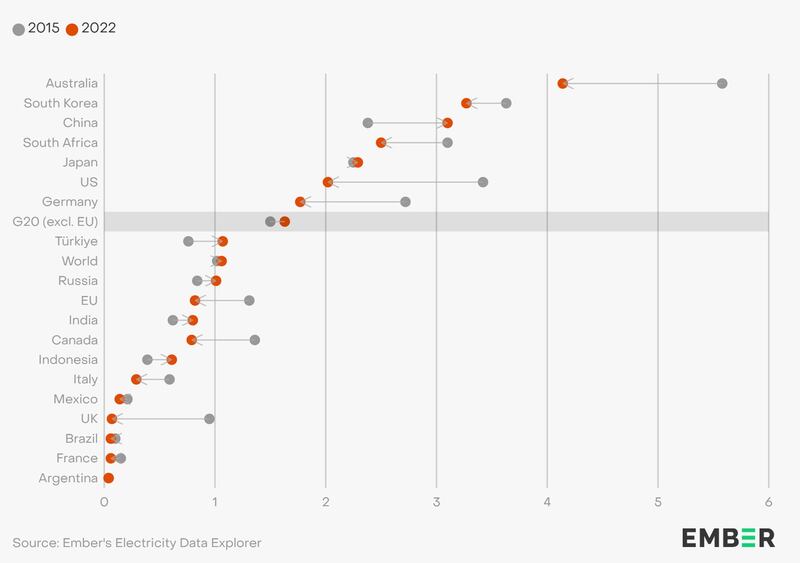China’s per capita coal power emissions rose by 30% between 2015 and 2022 as it continued to remain one of the top polluters in the world, a global energy research organization said in a new report on Tuesday.
Australia, South Korea, and China are the G20's top coal polluters on average, even though more countries are seeing decreasing coal-related emissions as they shift towards clean power, London-based Ember said in its report released ahead of the New Delhi meeting of the world's 20 biggest economies.
China was in third place among the six G20 countries that experienced rises in per capita emissions. However, in absolute numbers, its increase of 0.72 metric tons of carbon dioxide (CO2) was the highest per capita between 2015 and 2022.
China’s per capita coal emissions have increased by about 4% annually, while it has also added a whopping 670 Gigawatts (GW) of renewables since 2015.
The report said Australia and South Korea each emit three times the world average, with 48% of the electricity generation Down Under coming from coal and 34% of South Korea’s in 2022.
“As mature economies, they should be scaling up renewable electricity ambitiously and confidently enough to enable coal to be phased out by 2030,” said Dave Jones, an electricity analyst at Ember.
The duo have remained at the top since 2020, while China replaced South Africa to claim the third position this year.
Coal combustion releases harmful pollutants and greenhouse gases, contributing to climate change and environmental degradation.
G20 citizens have higher coal emissions
The G20, which accounts for 85% of global GDP, is responsible for 80% of global emissions related to the power sector. Its per capita emissions rose nearly 7% from coal-fired power since 2015, thanks to six countries whose emissions increased in the last seven years.
Across the world, more than one-third of the global electricity was generated from coal in 2022, producing 8,367 million metric tons of carbon emissions, which on average would be around 1.1 tonnes of CO2 emission.
However, among G20 nations, an individual’s coal emissions were notably more elevated, with per capita figures reaching 1.6 tonnes of CO2, according to Ember.

Even though 75 countries have already phased out or stopped building coal plants without carbon capture, seven major G20 nations - Brazil, China, India, Japan, South Korea, South Africa, and the United States - have not unveiled their coal phase-down strategies.
Japan’s per capita coal emissions have also grown, albeit at a slower pace of just 2% from 2015, making it the only developed country among the G20 to see its coal emissions increase since the 2015 Paris Agreement.
China’s coal power plant spree
China is currently the world’s biggest coal consumer and the largest greenhouse gas emitter.
According to new data released last week, China has recently gone on a "frantic permitting and construction" spree of new coal plants, which accounts for 70% of this capacity globally.
The Global Energy Monitor and the Centre for Research on Energy and Clean Air said that China brought 25.9 GW of coal-fired power capacity online in the first six months of 2023.
It also started construction on 37 GW of new coal power capacity, gave permission for 52 GW, announced 41 GW of new projects, and revived 8 GW of previously shelved projects.
“All of these parts of the project pipeline are currently running at a pace of more than one coal power plant per week,” the report said.
Outside China, India has the most planned coal power, while Indonesia, Japan, and Vietnam are among the few Asian countries building the world’s new coal plants.
Indonesia’s highest rise in coal emissions
Southeast Asia’s most populous nation Indonesia witnessed the highest percentage rise among the G20, with per capita coal power emissions surging by 56% from 2015 to 2022, according to Ember.
Last month, Jakarta was ranked the world’s most polluted city, partly blamed on the eight coal-fired power stations, the highest in the world near the capital.
Indonesia, which uses coal for almost a third of its electricity, is also the world’s largest coal exporter. Australia is second.

India, the host of the G20 Summit this weekend, experienced a 29% increase in seven years, Ember said.
While the number of coal power projects under development decreased by 85% between 2015 and 2022, there has been a rise in coal approvals over the past 12 months marking “a change in India’s energy transition pattern.”
India, like China, is currently experiencing rapid electricity demand growth, with climate change-induced impacts, like floods and droughts, hampering the progress even though renewables have expanded in recent years.
“As a result, their coal-fired generation has also increased in this period,” Ember said.
In July, prominent fossil fuel nations, including China, Saudi Arabia, Russia, and Indonesia, resisted an initiative to increase the G20 nations’ renewable energy capacity by threefold by 2030.
Edited by Mike Firn and Taejun Kang.
